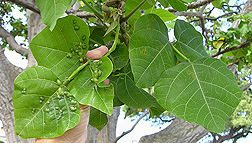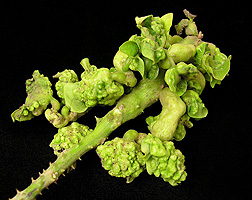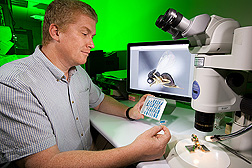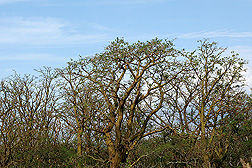Hawaii Hosts Wasp-on-Wasp Battle Royale
|
|
A black, 2-millimeter-long wasp from East Africa is helping wage war on one of its own kind–the Erythrina gall wasp (Quadrastichus erythrinae), an invasive species that has decimated Hawaii’s wiliwili and coral bean trees. Hawaii Department of Agriculture (HDOA) officials made the first release of the beneficial African wasp—500 specimens mass-reared in captivity—on November 28, 2008, at a gall-infested wiliwili stand in the Liliuokalani Botanical Gardens, Honolulu.
Michael Gates and Gérard Delvare’s scientific description and naming of the beneficial species (Eurytoma erythrinae) earlier that year helped HDOA obtain the necessary federal approvals to make the release. Gates and Delvare, both entomologists, are with the Agricultural Research Service and the Commonwealth Scientific and Industrial Research Organization, respectively.
“The gall wasp has been traveling around the globe for years,” says Gates, who works in ARS’s Systematic Entomology Laboratory at the Smithsonian’s National Museum of Natural History in Washington, D.C. “It is native to East Africa and has spread via the Indian and Pacific Ocean basins. It was detected in Oahu in April 2005 and in Florida in the fall of 2006.”
|
|
How the gall wasp arrived is unknown, but the pest quickly found suitable hosts on which to feed and reproduce, first on Oahu, then on other Hawaiian islands. HDOA officials hope their biologically based approach to controlling the invasive wasp will spare further harm to Hawaii’s thinning ranks of indigenous wiliwili trees and introduced tropical coral bean trees, which are commonly used for landscaping, soil and water conservation, and as windbreaks.
The gall wasp’s larval stage is to blame for the harm that’s been caused. After hatching from eggs deposited in leaf and stem tissue, the larvae induce irregular plant growths called “galls” in which to feed. They pupate and emerge as adults 14 days later to feed, mate, and start the cycle of destruction over again. Heavily galled leaves become curled and misshapen. Severe infestations can defoliate and eventually kill afflicted trees.
The galls, coupled with the pest’s establishment throughout the Hawaiian islands, have made topically applied insecticides ineffectual and systemic ones too costly. But now, these selfsame galls could become the pest’s tombs, thanks to the ability of female E. erythrinae wasps to find the chambers and deposit their own eggs inside. Upon hatching, the brood feed on gall wasp larvae, then pupate and emerge 2 weeks later as adults. Importantly, E. erythrinae wasps pose no apparent danger to nontarget insects, such as native wasps.
|
|
The Hawaiians found their “gall wasp gladiator” after dispatching two entomological teams to the pest’s native Africa in search of natural enemies, starting in spring 2006. Quarantine studies of parasite specimens the teams returned with showed the now-named E. erythrinae (discovered in Tanzania by HDOA entomologist Mohsen Ramadan) to be the most host-specific and dominant of the bunch. In January 2007, Gates and Delvare were asked to identify Ramadan’s candidate wasp based on their taxonomic expertise in the genus Eurytoma.
Their examination of 27 female and 17 male specimens included dissecting several to observe their internal and external structures and compare them with existing scientific illustrations and descriptions of other related wasp species, many of which are preserved in collections at the Museum of Natural History in Paris.
“We also used a scanning electron microscope to obtain images, and we used an Entovision system, which combines multiple images into a single, in-focus image. This essentially eliminates depth-of-field and exposure limitations encountered with traditional macrophotography,” says Gates. Based on their analysis, he and Delvare concluded that the parasite was a new Eurytoma species. They published their findings in the April 2008 issue of the journal Zootaxa.
|
|
After a slow start resulting from a cool Hawaiian winter, the 2009 E. erythrinae population appears to have gained solid footing. As of May 2009, specimens had been recovered from 90 percent of the original release sites and, in some cases, beyond, say Neil Reimer and Juliana Yalemar, both with HDOA’s Division of Plant Industry.
Gall-wasp parasitism has been as high as 70 percent at some sites. But continued data collection will be necessary to correlate E. erythrinae’s rise to declines in tree damage, especially wiliwili, which grows in dryland forests on the leeward slopes of Hawaii’s islands.
“It’s a bit early to tell what impact the E. erythrinae are having on the gall wasps, but the coral trees are starting to look pretty good,” Reimer says.—By Jan Suszkiw, Agricultural Research Service Information Staff.
This research is part of Crop Protection and Quarantine, an ARS national program (#304) described at www.nps.ars.usda.gov.
Michael Gates is at the USDA-ARS Systematic Entomology Laboratory, MRC-168, National Museum of Natural History, P.O. Box 37012, Washington, DC 20013; (202) 382-8982.
"Hawaii Hosts Wasp-on-Wasp Battle Royale" was published in the September 2010 issue of Agricultural Research magazine.










